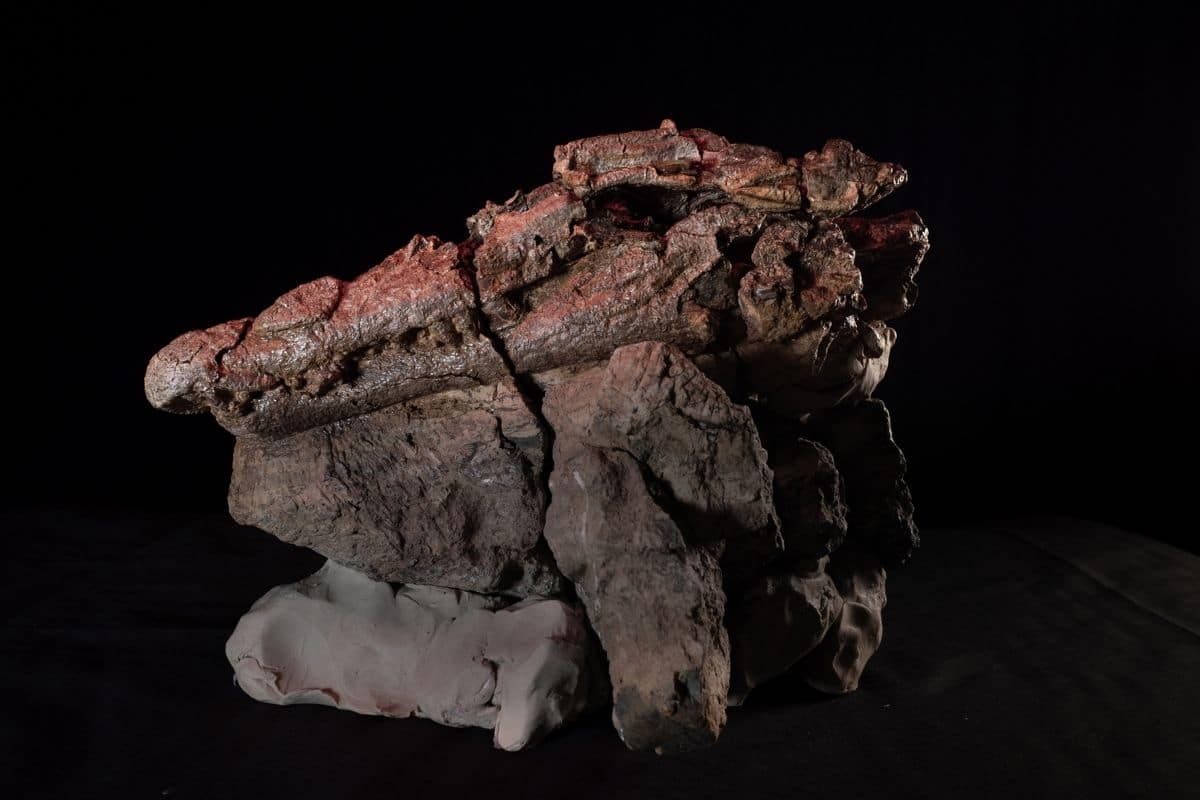

It seems that the primeval beast before taking his own life first feasted on an unfortunate baby dinosaur.
Australian scientists have found the remains of a previously unknown and millions of years old crocodile species. They write that in a new study, published in the journal Gondwana Research† But that’s not even the most special thing. Because after further analysis, the ancient crocodile appears to have eaten a remarkable last meal: a real dinosaur.
fossil remains
The fossil remains of the crocodile were discovered as early as 2010 on a large sheep farm near the Australian town of Winton. Although the crocodile was missing its tail and hind legs, among other things, many bones and even its skull with teeth turned out to be virtually intact.

The skull of Confractosuchus sauroktonos. Image: Australian Age of Dinosaurs
After further analysis, the researchers now discover that the remains of a still unknown species of crocodile were excavated at the time. The partial skeleton was recovered near the northwestern edges of the Winton Formation; a geological deposit dating back as much as 95 million years. The new, nearly 100 million-year-old ancient crocodile is Confractosuchus sauroktonos referred to as “broken dinosaur slayer.”
Dinosaur Killer
The prehistoric crocodile doesn’t have that nickname for nothing. After a thorough inspection of the fossil, the researchers make a remarkable discovery. In the stomach of the beast, the team found the partially digested remains of a real baby dinosaur. So it seems that the ancient crocodile had a special last meal and feasted on a herbivorous dinosaur from the Ornithopoda family.
the dinosaur
Probably, the ill-fated animal did not suffer long. For example, the preserved bones show that the moment the crocodile closed its powerful jaws around the delicate dinosaur body, the dinosaur probably died fairly quickly. While the crocodile was working it down, one of the femurs was ripped in half. The other thigh was bitten so hard that a tooth mark on the bone is still visible.
Dinosaur-Eating Crocodiles
The discovery is a special one. Because as you can imagine, researchers do not regularly find dinosaurs in the gut contents of a Cretaceous crocodile. This is the first time researchers in Australia have found evidence of a dinosaur-eating crocodile. Incidentally, the unfortunate dino was probably easy prey for Confractosuchus† Using CT scans and 3D models, the researchers calculated that the dinosaur must have weighed just 1.7 kilograms when it was captured. “The crocodile was about 2.5 meters long at the time and was still growing,” said study researcher Matt White. “Although Confractosuchus If he didn’t just eat dinosaurs, he wouldn’t have passed up such an easy meal.” Shortly after this meal, however, this predatory crocodile also met its end.
The discovery of a dinosaur-hunting crocodile provides interesting new insight into the complex ecology that existed during the Cretaceous Period. The researchers therefore suspect that dinosaurs may have played an important role in the ecological food web. So they were not only scavengers and predators, but also prey. “Given the lack of comparable worldwide specimens, the prehistoric crocodile and its last meal provides clues about the relationships and behavior of the animals that inhabited Australia millions of years ago,” concludes White.
Source material:
†Crocodile discovered with dinosaur in stomach” – Australian Age of Dinosaurs
Image at the top of this article: Australian Age of Dinosaurs